Spanish architect Jose Rafael Moneo is using 2500 m2 of alabaster to glaze the windows of the new Cathedral of Our Lady of the Angels in Los Angeles (see case study, overleaf). And architect Nicholas Grimshaw & Partners is using marble as a glazing material in the Fundacion Caixa Galicia art gallery in the city of La Coruña in Spain.
Mankind has spent hundreds of years perfecting glass technology, so there must be very good reasons for architects to turn their backs on it and use materials that barely admit light and curl up or degenerate when exposed to the sun.
Grimshaw decided to use white marble for both glazing and cladding the art gallery because it neatly fulfilled the client's conflicting demands. As project architect Kirsten Lees explains: "The brief from the client was full of contradictions. They wanted a building that was traditional but modern, formal but informal and solid but transparent." The marble does this by looking solid and white during the daytime, but is also translucent so light can pass through it.
This translucency has been used to good effect in two distinct areas. At basement and ground-floor level, marble windows diffuse the strong Spanish sun but can be opened for more direct light if needed. Higher up, the marble cladding is lit from behind at night so that it glows gently.
Grimshaw's art gallery used white marble to echo other buildings in the city. "We initially looked at metal cladding, then we got to know the area and began to look for a white material that would reflect the location," says Lees. One of La Coruña's distinctive features is its white, glass-panelled balconies – known as gallerias – that give the city its characteristic white look.
The architect rejected specialist glass because it didn't fulfil the demanding brief. "We looked at frosted glass, but it looks green rather than white," explains Lees. "We then looked at crystallised glass but it looked a bit flat."
The answer came in the form of a Carrera marble called Bianco Candido. "We held it up to the light and at 30 mm thick it was amazing how much light came through," recalls Lees. "We liked it because of the balance of its aesthetic qualities – its texture, its appearance when not translucent and the fact it is also very translucent and has some very soft veining in it."
The whole building is clad in marble except for a clear glass strip that slices through the middle to allow light into a central atrium. The marble sweeps seamlessly from the lower ground floor up the inclined facade and over the roof in an unbroken curve; the building is higher at the front and lower at the rear to match the heights of existing buildings in the streets at the front and rear of the gallery.
The marble has to do three jobs – windows, cladding and roofing – it has been given similar treatment over the whole building. The windows at the lower levels work as a series of louvres that swivel open. Above this, the marble matches the windows as a continuum of overlapping panels that carry on in the same way over the roof. Above the windows sits a marble rainscreen set in front of the solid gallery wall, and light projectors sit in the gap to illuminate the facade from behind. A transparent glass screen sits in front of the cladding at the same height as the adjacent gallerias, upon which images can be projected.
Behind the facade on the upper levels are art galleries, gently illuminated by borrowed light through the internal walls facing the atrium, which are laminated glass with an interlayer of muslin. Had the decision to use translucent marble on the facade been taken earlier in the project, it could have been used to provide diffused light directly to the galleries from outside – but the solid external walls were already designed in, and it was too late.
Ensuring marble would work on the project required careful research. Initially, the architect looked at using solid panels of marble, but quickly identified a phenomenon called thermal hysteresis. Cyclical cooling and heating cause the marble to curl up at a thickness of 25-50 mm – precisely the range of thickness ideal for cladding. The same problem affected Finlandia Hall in Helsinki, which was clad in marble when built in 1971 but recently had to be reclad.
As 95% of marbles are affected by thermal hysteresis, Lees struggled to find a suitable one. Her task was made even more onerous as the marble also had to be white and translucent. The architect then hit upon the idea of selecting the marble on aesthetic grounds alone and using thin sheets of it attached to laminated glass.
"By gluing the marble onto glass we got the structural qualities of glass and the aesthetic qualities of the marble," says Lees.
The glass contractor making up the panels has yet to test the material, although it is confident of success. Panels 900 mm high and 1500 mm wide will be made from 10 mm thick sheets of marble glued onto 20 mm thick laminated glass. Light modelling and full-scale mock-ups will be built to test the light transmittance properties of the material and to check whether it is stable before the whole building is clad, ready for completion in December 2003.
LA story: Glazing the Cathedral of Our Lady of the Angels

Downloads
Diagram: How the alabaster keeps its cool
Other, Size 0 kb
Doors and windows
- 1
- 2
- 3
 Currently reading
Currently readingWindows 2002
























No comments yet